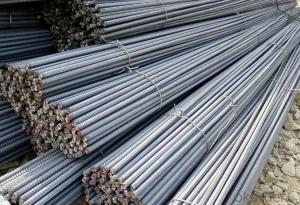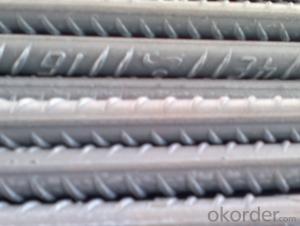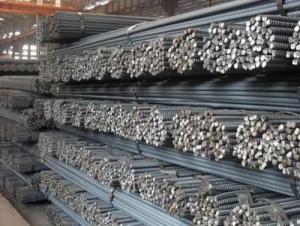HRB500 Deformed Steel Bar
- Loading Port:
- China Main Port
- Payment Terms:
- TT or LC
- Min Order Qty:
- 25MT m.t.
- Supply Capability:
- 800000/YEAR m.t./month
OKorder Service Pledge
OKorder Financial Service
You Might Also Like
Specifications of HRB500 Deformed Steel Bar:
Standard | GB | HRB500 |
Diameter | 6mm,8mm,10mm,12mm,14mm,16mm,18mm,20mm, 22mm,25mm,28mm,32mm,36mm,40mm,50mm | |
Length | 6M, 9M,12M or as required | |
Payment term | TT or L/C | |
Application | mainly used in construction industry to reinforce concrete structures and so on | |
Quality | First quality, the goods are from Chinese big manufacturers. | |
Type | Hot rolled deformed steel bar | |
Brand name | DRAGON | |
Chemical Composition: (Please kindly find our chemistry of our material based on HRB500 as below for your information)
Grade | Technical data of the original chemical composition (%) | ||||||
C | Mn | Si | S | P | V | ||
HRB500 | ≤0.25 | ≤1.60 | ≤0.80 | ≤0.045 | ≤0.045 | 0.08-0.12 | |
Physical capability | |||||||
Yield Strength (N/cm²) | Tensile Strength (N/cm²) | Elongation (%) | |||||
≥500 | ≥630 | ≥12 | |||||
Theoretical weight and section area of each diameter as below for your information:
Diameter(mm) | Section area (mm²) | Mass(kg/m) | Weight of 12m bar(kg) |
6 | 28.27 | 0.222 | 2.664 |
8 | 50.27 | 0.395 | 4.74 |
10 | 78.54 | 0.617 | 7.404 |
12 | 113.1 | 0.888 | 10.656 |
14 | 153.9 | 1.21 | 14.52 |
16 | 201.1 | 1.58 | 18.96 |
18 | 254.5 | 2.00 | 24 |
20 | 314.2 | 2.47 | 29.64 |
22 | 380.1 | 2.98 | 35.76 |
25 | 490.9 | 3.85 | 46.2 |
28 | 615.8 | 4.83 | 57.96 |
32 | 804.2 | 6.31 | 75.72 |
36 | 1018 | 7.99 | 98.88 |
40 | 1257 | 9.87 | 118.44 |
50 | 1964 | 15.42 | 185.04 |
Usage and Applications of HRB500 Deformed Steel Bar:
Deformed bar is widely used in buildings, bridges, roads and other engineering construction. Big to highways, railways, bridges, culverts, tunnels, public facilities such as flood control, dam, small to housing construction, beam, column, wall and the foundation of the plate, deformed bar is an integral structure material. With the development of world economy and the vigorous development of infrastructure construction, real estate, the demand for deformed bar will be larger and larger..
Packaging & Delivery of HRB500 Deformed Steel Bar:
Packaging Detail: products are packed in bundle and then shipped by container or bulk vessel, deformed bar is usually naked strapping delivery, when storing, please pay attention to moisture proof. The performance of rust will produce adverse effect.
Each bundle weight: 2-3MT, or as required
Delivery Detail: within 45 days after received advanced payment or LC.
Label: to be specified by customer, generally, each bundle has 1-2 labels
Trade terms: FOB, CFR, CIF
Deformed Steel Bar in stock
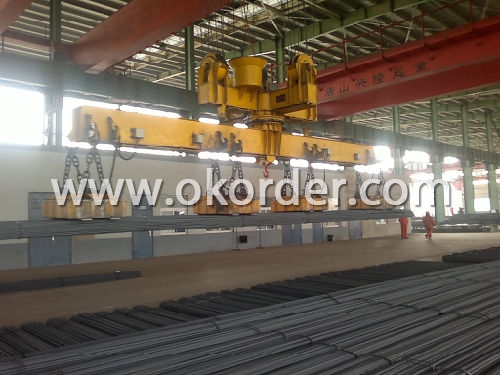
Deformed Steel Bar in testing
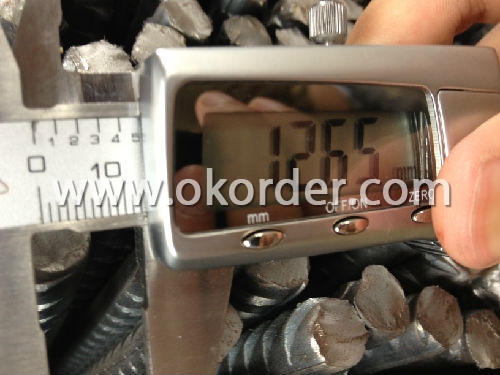
Note:
1. Our products are produced according to national standard (GB), if not, supply according to national standards (GB) or agreement as customer required.
2. Other Grade and Standard Deformed Steel Bar we can supply:
Grade: GR40/GR60, G460B/B500A/B500B/B500C,BST500S
Standard: ASTM, BS, DIN
The Minimum Order Quantity of these products is high, and need to be confirmed.
3. We can not only supply Deformed Steel Bar; if you need anything about building materials, please contact us for further information.
4. Please send us your detail specifications when inquire. We will reply to you as soon as possible. We sincerely hope we can establish a long stable business relationship.
- Q:Can steel rebars be used in energy-efficient buildings?
- Certainly! Energy-efficient buildings can indeed incorporate steel rebars. These rebars are commonly utilized in the construction of reinforced concrete structures, including those that prioritize energy efficiency. Energy-efficient buildings aim to decrease energy consumption and minimize their environmental footprint. Although steel is a material with high embodied energy, meaning it requires a substantial amount of energy for production, it boasts numerous advantages for energy-efficient buildings. To begin with, steel rebars lend structural strength to reinforced concrete, enabling the creation of robust and long-lasting structures. This is pivotal for energy-efficient buildings, as their goal is to have an extended lifespan and reduced maintenance requirements, thereby lessening their overall environmental impact. Additionally, steel rebars can be employed in the construction of energy-efficient building components, such as insulated concrete forms (ICFs) and precast concrete panels. These building systems possess exceptional thermal insulation properties, which decrease heat transfer and enhance energy efficiency. Steel rebars are utilized to reinforce these components, ensuring their structural integrity. Furthermore, the thermal mass characteristics of concrete, reinforced by steel rebars, can contribute to a building's energy efficiency. Concrete has the capability to absorb and store heat, aiding in the regulation of indoor temperatures and reducing the need for excessive heating or cooling. Consequently, this can result in significant energy savings throughout a building's lifespan. It is important to note that the energy efficiency of a building is contingent upon various factors, including insulation, window design, HVAC systems, and the integration of renewable energy. While steel rebars play a vital role in reinforced concrete structures, their impact on overall energy efficiency should be evaluated in conjunction with other design choices and building materials.
- Q:How do steel rebars affect the durability of a structure?
- Steel rebars have a significant impact on the durability of a structure. These reinforcements, made of high-strength steel, are embedded within concrete to enhance its tensile strength and overall structural integrity. By providing resistance against cracking and flexural stresses, steel rebars help in preventing structural failures and ensuring the long-term durability of the construction. One of the main benefits of using steel rebars is their ability to withstand tension forces. Concrete, although strong in compression, is weak when it comes to tension. When a structure is subjected to loads that cause bending or stretching, the rebars distribute these forces throughout the concrete, preventing it from cracking or breaking apart. This reinforcement improves the overall load-bearing capacity of the structure, making it more resistant to external forces such as earthquakes or heavy winds. Moreover, steel rebars also play a crucial role in preventing corrosion within the structure. Concrete is porous, and over time, moisture can penetrate it, causing the embedded reinforcement to rust. Rusting rebars expand, leading to cracks and weakening the structure. However, using corrosion-resistant rebars, such as epoxy-coated or stainless steel rebars, significantly reduces the risk of corrosion, thus enhancing the durability of the structure. In addition to their mechanical properties, steel rebars also contribute to the durability of a structure in terms of construction speed and long-term maintenance. Compared to other traditional reinforcement materials, rebars are relatively easy to install, reducing construction time and costs. Furthermore, their long lifespan and low maintenance requirements ensure the longevity and durability of the structure over time. In conclusion, steel rebars are essential for ensuring the durability of a structure. Their ability to resist tension forces, prevent cracking, and mitigate the risk of corrosion significantly enhances the structural integrity and longevity of the construction. Incorporating steel rebars into the design and construction process is crucial to creating sturdy, safe, and long-lasting structures.
- Q:Why is thread steel thinner than crude?
- Thread steel is used for the construction of reinforced concrete facilities, his material is generally low alloy steel grades is generally 16Mn (16 Mn low-alloy steel), or 45 carbon just, their yield strength is above 350Mpa, tensile strength 500Mpa, low carbon steel round steel than ordinary much higher (after heat treatment of the steel strength than low carbon steel nearly twice as high or higher)
- Q:Are steel rebars suitable for use in structures with high resistance to impact?
- Structures with high resistance to impact can generally make use of steel rebars. These rebars, also known as reinforcement bars, are made from steel and are commonly utilized in concrete structures to enhance their strength and durability. Steel possesses high tensile strength and the ability to absorb and distribute impact forces, making it an excellent material for reinforcement. In situations where impact is a concern, like in bridges, highways, or buildings located in earthquake-prone areas, steel rebars perform a critical function by providing additional strength and resistance. By incorporating rebars, the structure becomes capable of withstanding sudden impact loads and preventing catastrophic failures. Furthermore, engineers have the option to choose from various grades and sizes of steel rebars, ensuring that the appropriate type is selected based on the specific requirements of the structure. Higher grade rebars, such as Grade 60 or Grade 75, offer increased strength and ductility, making them particularly suitable for structures with high resistance to impact. It is worth noting that while steel rebars enhance the overall strength and impact resistance of a structure, other factors such as design, construction techniques, and maintenance also play significant roles in ensuring the structure's ability to withstand impact forces. Therefore, taking a comprehensive approach that encompasses all these factors is crucial when designing and constructing structures with high resistance to impact.
- Q:How are steel rebars transported to the construction site?
- Steel rebars, also known as reinforcing bars, are typically transported to construction sites using various methods. One common method is by truck transportation. The rebars are loaded onto flatbed trucks or trailers and secured using straps or chains to prevent any movement during transit. These trucks are specifically designed with sturdy frames and loading mechanisms to handle the weight and length of the rebars. Another method is by rail transportation. Steel rebars can be loaded onto rail cars, either on flatcars or in specialized containers, and transported to the construction site. This method is often used for long-distance transportation, as it is more cost-effective and efficient for large quantities of rebars. In some cases, rebars can also be transported by sea or barge for construction projects located near waterways. They are loaded onto ships or barges and secured to prevent any damage or movement during transit. This method is commonly used for projects that require large quantities of rebars or for construction sites located on islands or in coastal areas. Once the steel rebars arrive at the construction site, they are typically unloaded using cranes or forklifts. The rebars are then stored in designated areas or directly used for reinforcement in the construction process. It is essential to handle the transportation of rebars with care to ensure their structural integrity and prevent any potential accidents or damage during transit.
- Q:What are the guidelines for inspecting and testing steel rebars on-site?
- The guidelines for inspecting and testing steel rebars on-site typically include visually examining the rebars for any visible defects such as rust, cracks, or bends. Additionally, non-destructive testing methods like ultrasonic testing or magnetic particle inspection may be employed to detect any internal flaws or inconsistencies in the rebars. It is also crucial to ensure that the rebars meet the specified dimensions, lengths, and quality standards as per the project requirements. Regular sampling and testing of rebars are essential to maintain the structural integrity and safety of the construction project.
- Q:What is the role of steel rebars in the construction of foundations?
- Steel rebars play a crucial role in the construction of foundations as they provide reinforcement and strength to the concrete structures. By being embedded in the concrete, rebars enhance the tensile strength and durability of the foundation, helping it withstand heavy loads, prevent cracking, and resist deformation caused by ground movement or settling.
- Q:Can steel rebars be used in marine structures?
- Yes, steel rebars can be used in marine structures. Steel is a commonly used material in marine construction due to its strength, durability, and resistance to corrosion. However, it is important to use the appropriate type of steel rebars that are specifically designed for marine applications. These rebars are usually made of stainless steel or galvanized steel, which have enhanced corrosion resistance properties compared to regular carbon steel rebars. Additionally, an extra layer of protection such as epoxy coating or cathodic protection systems can be applied to further increase the rebars' resistance to corrosion in harsh marine environments. Regular maintenance and monitoring are also essential to ensure the long-term performance and integrity of steel rebars in marine structures.
- Q:How are steel rebars spliced or connected in construction joints?
- Various methods are used to splice or connect steel rebars in construction joints, ensuring the integrity and strength of reinforced concrete. A common method is lap splicing, where rebars are overlapped and then mechanically connected or tied together with steel wires or couplers. The required overlap length for lap splicing depends on the rebar diameter and design specifications, often specified as a multiple of the diameter. This length guarantees efficient load transfer and prevents potential failures at the connection point. Mechanical couplers offer an alternative method for splicing rebars. These pre-fabricated devices securely connect two rebars, eliminating the need for lap splicing and providing a more precise and reliable connection. Mechanical couplers are particularly useful when dealing with larger rebar sizes or when long lap lengths are not feasible. In certain cases, welded splicing may be used. This method involves welding the ends of rebars together, creating a solid and continuous connection. Welded splicing is commonly employed when dealing with larger diameter rebars and higher load requirements. However, it is crucial to adhere to proper welding techniques and practices to maintain the connection's integrity. Overall, the splicing or connection of steel rebars in construction joints is a crucial aspect of reinforced concrete construction. It ensures that rebars function as continuous reinforcement, enabling structures to effectively resist applied loads. The choice of splicing method depends on factors such as rebar size, design specifications, and project requirements.
- Q:How do steel rebars contribute to the load-bearing capacity of structures?
- Steel rebars contribute to the load-bearing capacity of structures in several ways. Firstly, they enhance the tensile strength of the concrete. While concrete is strong in compression, it is relatively weak in tension. By adding steel rebars to the concrete, the tensile strength of the structure is significantly increased. This is crucial as structures are subjected to various loads, including dead loads (e.g. the weight of the structure itself), live loads (e.g. occupants, furniture), and environmental loads (e.g. wind, earthquakes). Secondly, steel rebars help to prevent cracking and improve the overall durability of the structure. Concrete has a tendency to shrink and crack due to temperature changes, moisture, and other factors. By placing steel rebars within the concrete, they act as reinforcement and help to distribute the load more uniformly, reducing the likelihood of cracking. This improves the structural integrity and longevity of the building. Furthermore, steel rebars also provide stability and support to the structure. They help to resist the lateral forces that can occur during high winds or seismic events. By anchoring the rebars into the foundation or other structural elements, they create a strong connection that can withstand these lateral loads and prevent the structure from collapsing or being damaged. In summary, steel rebars play a crucial role in enhancing the load-bearing capacity of structures by improving the tensile strength of the concrete, preventing cracking, and providing stability and support. Their integration into the structural design ensures the safety, durability, and long-term functionality of buildings and other infrastructure.
1. Manufacturer Overview |
|
|---|---|
| Location | Hebei, China |
| Year Established | 2002 |
| Annual Output Value | Above US$ 400 Million |
| Main Markets | South Asia; Middle East;Southeast Aisa |
| Company Certifications | |
2. Manufacturer Certificates |
|
|---|---|
| a) Certification Name | |
| Range | |
| Reference | |
| Validity Period | |
3. Manufacturer Capability |
|
|---|---|
| a)Trade Capacity | |
| Nearest Port | Tianjin |
| Export Percentage | 60%-80% |
| No.of Employees in Trade Department | 11-20 People |
| Language Spoken: | English; Chinese |
| b)Factory Information | |
| Factory Size: | Above 100,000 square meters |
| No. of Production Lines | 2 |
| Contract Manufacturing | OEM service offered |
| Product Price Range | average |
Send your message to us
HRB500 Deformed Steel Bar
- Loading Port:
- China Main Port
- Payment Terms:
- TT or LC
- Min Order Qty:
- 25MT m.t.
- Supply Capability:
- 800000/YEAR m.t./month
OKorder Service Pledge
OKorder Financial Service
Similar products
New products
Hot products
Hot Searches
Related keywords








